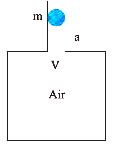Complete Solutions to Additional Exercises of chapter OSCILLATIONS of Class 11 book with complete answers and questions
| Class 11 | PHYSICS |
| Chapter | OSCILLATIONS |
| NCERT GUJARATI | Additional Exercises |
| Number Of Questions | 6 |
| Academic Year | 2023-24 |
An air chamber of volume V has a neck area of cross section a into which a ball of mass m just fits and can move up and down without any friction (Fig.14.27). Show that when the ball is pressed down a little and released , it executes SHM. Obtain an expression for the time period of oscillations assuming pressure-volume variations of air to be isothermal [see Fig. 14.27].
 03:36View Solution
03:36View SolutionYou are riding in an automobile of mass 3000 kg. Assuming that you are examining the oscillation characteristics of its suspension system. The suspension sags 15 cm when the entire automobile is placed on it. Also, the amplitude of oscillation decreases by 50% during one complete oscillation. Estimate the values of (a) the spring constant k and (b) the damping constant b for the spring and shock absorber system of one wheel, assuming that each wheel supports 750 kg.
05:24View SolutionShow that for a particle in linear SHM the average kinetic energy over a period of oscillation equals the average potential energy over the same period.
03:40View SolutionA circular disc of mass 10 kg is suspended by a wire attached to its centre. The wire is twisted by rotating the disc and released. The period of torsional oscillations is found to be 1.5 s. The radius of the disc is 15 cm. Determine the torsional spring constant of the wire. (Torsional spring constant a is defined by the relation `J = –alphatheta` , where J is the restoring couple and q the angle of twist).
02:30View SolutionA body describes simple harmonic motion with an amplitude of 5 cm and a period of 0.2 s. Find the acceleration and velocity of the body when the displacement is (a) 5 cm (b) 3 cm (c) 0 cm.
03:21View SolutionA mass attached to a spring is free to oscillate, with angular velocity `omega`, in a horizontal plane without friction or damping. It is pulled to a distance `x_(0)` and pushed towards the centre with a velocity `v_(0)` at time t = 0. Determine the amplitude of the resulting oscillations in terms of the parameters `omega, x_(0)` and `v_(0)`. [Hint : Start with the equation `x = a cos (omegat+theta)` and note that the initial velocity is negative.]
02:40View Solution
Additional Exercises questions and complete solutions for chapter OSCILLATIONS of NCERT PHYSICS(GUJRATI) of Class 11
